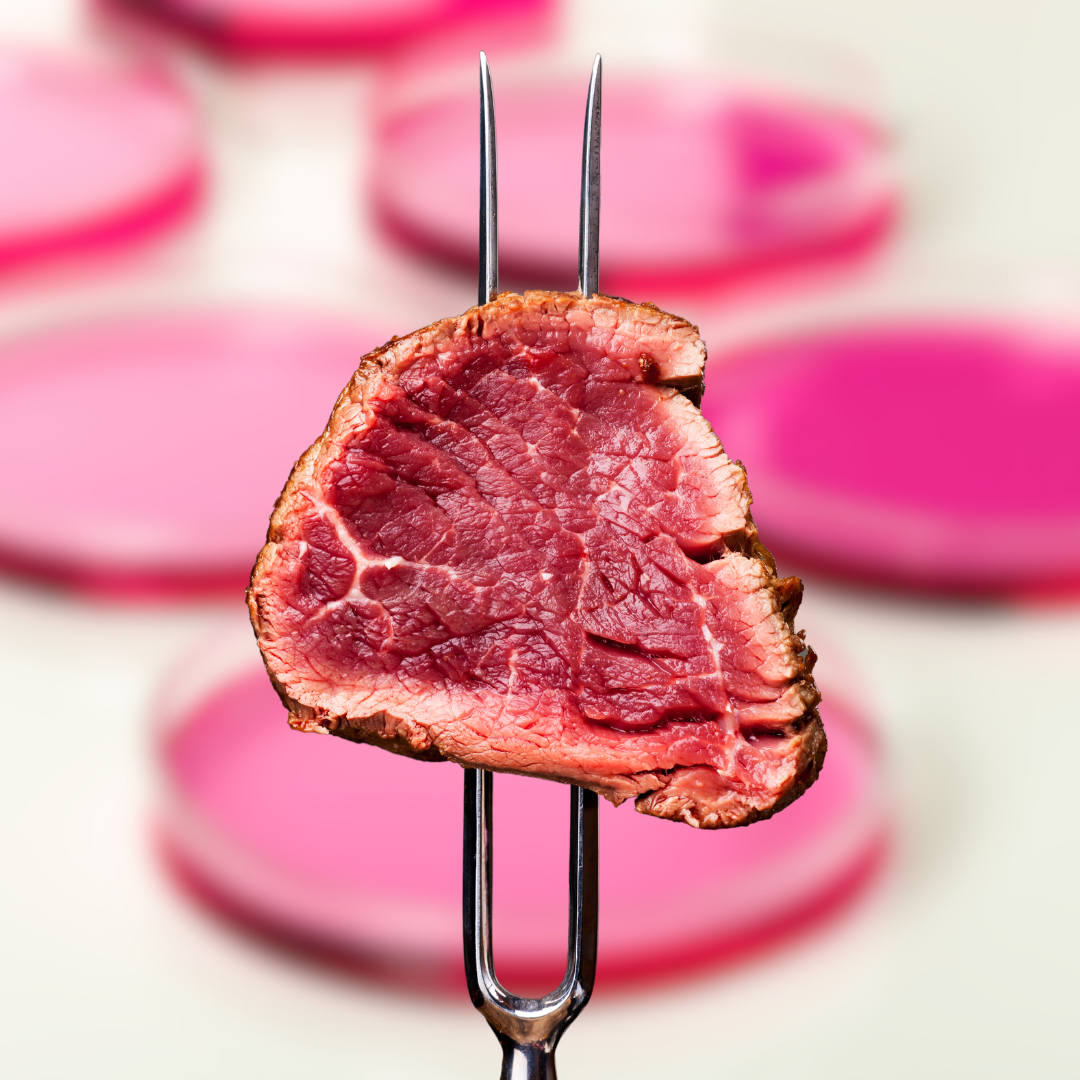Consumer trends drive the need for new product innovations that satisfy specialised consumer needs, resulting in new market challenges & opportunities. Plant-based alternatives to animal products are rapidly expanding and the majority of sales are coming from non-vegans. It is, therefore, crucial to understand what drives “Flexitarians”. Often it is a case of taste rules, protein matters and “natural” is better and this is where hybrid beverages come in.
From a food science and nutrition perspective, it is important to recognise the nutritional value of a varied diet that includes both animal and plant-based products and the associated challenges that both present. It is also important to understand the parameters that can influence the quality and quantity of plant-based proteins and whether the nutritional profile can satisfy dietary protein requirements throughout life. Innovation by design can help us to alleviate those areas of consideration and launch products that are more likely to be successful in the marketplace.
Last month, I issued a post to give some perspective of the benefits of using multifunctional and nutritional fibres to enrich some of the well-established product categories and delight consumers with new textures and experiences. This month, the primary objective of Part 2 aims at defining the landscape of commercial plant-based opportunities available to entrepreneurs, food manufacturers and strategists alike while meeting the requirements of savvy customers who are not willing to compromise on taste, texture and nutrition. Whey proteins can help to bridge this gap and I am going to give you an overview of their benefits within a flexitarian or reducetarian diet.
Note: My previous article referred to plant-based “mylks”, a term coined by Dr. Padayachee in her research. I find it useful when discussing both dairy and non-dairy options in the same post to have a term to differentiate both types so I will continue to use the term ‘mylk’ to refer to non-dairy or plant-based milk alternatives throughout this report.
Making the move to plant-based
Plant-based products, in general, offer us many key nutritional benefits. Each one of us could greatly benefit from increasing our plant intake even more. The nutritional equivalency between plant and animal proteins is not guaranteed and both have certain benefits that the other does not. I would like to consider our possibilities to enhance plant-based mylks with the nutritionally-rich areas of cow milks in order to continue to fortify their nutritional profile for consumers.
While plant-based diets are usually a natural source of dietary fibre, vegetarians and vegans need to choose combinations of foods that would provide an adequate protein intake, a key macronutrient readily available in meat, seafood, dairy and eggs. Plant-based diets must be carefully planned to meet the protein recommendations from a qualitative (protein digestibility PDCAAS) and quantitative (nutrient content claim, essential amino acids) perspective. Bio-accessibility, bioavailability, and digestibility may be concerns and need to be assessed during the development and scaling of food products.
The nutritional quality of plant-based proteins can be improved and enhanced with specific techniques such as fermentation, heat treatment, milling, germination, extrusion, reduction of chymotrypsin and trypsin inhibitors as well as other antinutritional factors. Alternatively, plant-based products can be enriched with other protein sources.

Why Whey?
Whey Protein is becoming an increasingly important protein of choice because of its proven health, nutrition and functional benefits. Whey proteins have high biological value, are rapidly digested and rich in Glutamine and branched-chain amino acids (BCAA) such as Leucine (needed for protein synthesis), Cysteine (boosting the immune system), and Threonine (maintaining gut barrier and function).
Unlike casein micelles, whey proteins contain a lot of sulfur (sulphurated amino acids) that permit the creation of well-defined (secondary) structures. They are essential to cellular health, muscle growth and protein synthesis. Whey proteins also contain growth factors and immune regulators.
From a functional perspective, whey proteins can form a gel, have good water holding capacity and foaming properties throughout a wide pH range to enhance texture and sensorial experience. They can add significant value in multiple product categories such as cheese, fish and meat analogues. Blending for nutritional balance and improvement in sensory acceptability is key for success to build insightful, authentic and sustainable branding strategies in the food space.
Plant-based dairy alternatives are perceived as being the healthier option in a consumer’s eyes. While highly beneficial and nutritious in many ways with additional nutrients (fibre, vitamins/minerals, antioxidants) without the saturated fats, they are still lacking in some other essential nutrients. For example, cow’s milk has approximately six per cent protein, 80 per cent of which is made up of casein, with the remaining 20 per cent being whey. Both of these are high quality (in terms of amino acids) and easily digestible proteins.
A typical serving of Almond Milk has only 1g of protein in comparison to dairy milk which contains 8g. Higher protein intake is something that we should all be aiming for so this is something that dairy alternative beverages should work on increasing. These types of non-dairy beverages are often also lacking in probiotics, omega-3 and calcium.
You may be thinking that we can get these nutrients in other food and beverage sources, so why do we need to include them in mylks as well? My response would be that milk has been a staple beverage in many diets across the world and cannot be immediately replaced by another food or beverage. If this was the case, plant-based mylks would not have experienced as much success as they have to date. We also know that plant proteins are of a lesser quality than animal proteins and therefore we need to increase our consumption. By including beneficial protein in as many meal occasions and products throughout the day as possible, we can ensure that consumers more easily reach their RDA. Overall, it creates opportunities for innovation, new and differentiating value propositions, as well as a more easily achievable complete nutrition diet.
Formulating plant-based products “by design” with whey proteins and other micronutrients will help us to build a model of customer appeal. It can be beneficial to meet the requirements of specific segments such as Seniors or Baby-Boomers and include key nutrients that could drive deficiency by not choosing meat.
The ageing population is one of the trends with the biggest impact on the future in terms of NPD. For older consumers, one of the most preventable changes associated with ageing is the loss of muscle mass and strength, known as sarcopenia. The addition of whey proteins can certainly help to build and maintain muscle mass. Texture may also need adjustment to counteract dysphagia for which a carefully selected blend of fibres combined with proteins in a specific food matrix would bring some additional nutritional benefits and improve the overall sensorial experience of eating. By carefully selecting the appropriate manufacturing steps and processing parameters, whey proteins can gel or increase viscosity (i.e. impact on texture and stability). They also have good water retention, emulsification and foaming properties to refine the appearance, stability, and texture of functional food and beverages.
Milk or Mylk?
In 2016, Sethi, S., [3] claimed that plant-based mylks were the fastest-growing segment in the newer food product development category of functional and speciality beverages across the globe.
According to Mintel, the biggest users of non-dairy milk in the UK are 16-24-year-olds with 33 per cent opting for plant-based alternatives. The three biggest drivers among this age group are typically based around health, ethics and the environment.
When it comes to the latter, choosing plant-based mylk is not always enough. Even within the category, there are better and worse contenders if environmental reasons are your main driver for consumption. In the graph below, you will see that soy and oat mylks are the overall best options for those concerned about the environment whereas rice and almond alternatives are higher in terms of water usage.

Graph source: BBC, 2019
We previously mentioned that based on the research from Vanga and Raghavan [4], the nutritional profile of commercial mylks is different from cow’s milk. This is reiterated in the graphs below for vitamins and minerals respectively. Note that in some instances, fortification of plant-based mylks may be required to satisfy the human needs for vitamins and minerals of vegans and vegetarians. There is a higher risk of deficiency in vitamins B12 and D, polyunsaturated fatty acids such as EPA (EicosaPentaenoic Acid), DHA (DocosaHexaenoic Acid) or Omega 3.
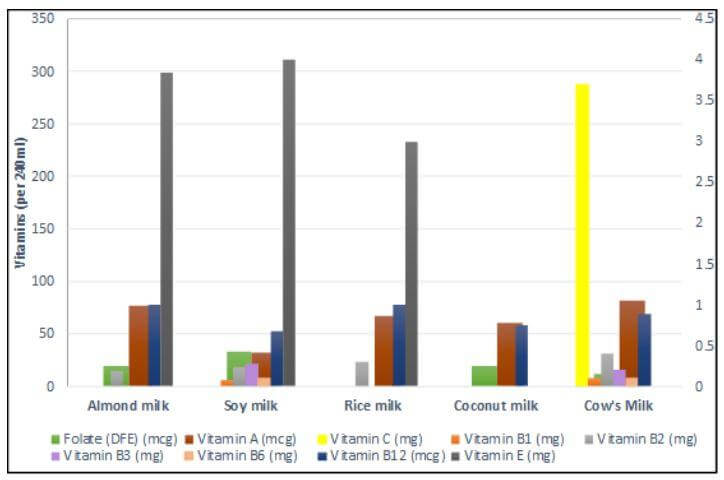
Graph source: [4] Vanga and Raghavan
In terms of minerals, note that the level of sodium must be monitored and daily intakes of minerals such as iron, zinc and calcium must also be assessed.
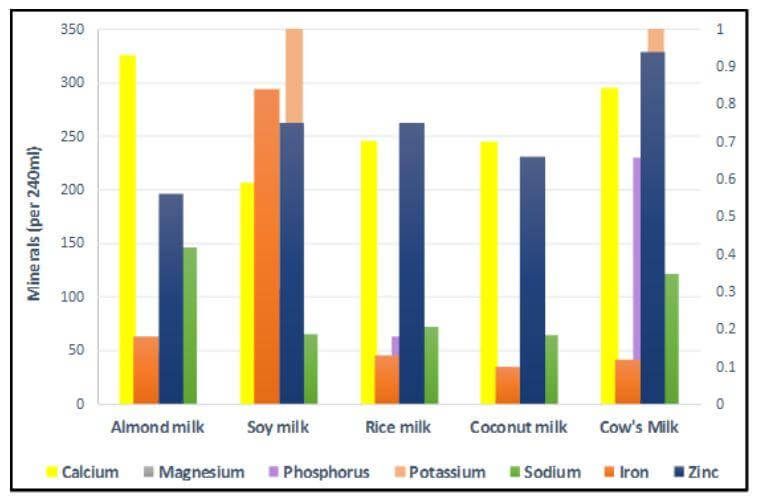
Graph source: [4] Vanga and Raghavan
From a functional perspective, several technological interventions have been put in place to counteract some of the limiting factors in the acceptance of plant-based mylks [3]. Shelf-life and product stability, development of off-flavours, inactivation or removal of inhibitors are all part of the challenges that food technologists and engineers are likely to be facing during development and scale-up. The addition of multi-functional proteins can alleviate some of those by building a new network and matrix with new physico-chemical properties.
Blending two or more types of milks and mylks, and fortifying with whey proteins is an important step to consider in the formulation and processing of new products for the flexitarian segment. Not only will it bring new sensory experiences or improve the current ones, but also improve and enhance functionality. It may also lead to new IP opportunities around bioprocessing (i.e. fermentation, enzymatic hydrolysis) and should trigger some insightful perspectives from the regulatory, quality and marketing functions. More to be revealed: let’s get the juice going!
When plant-based becomes mainstream
Today, the plant-based sector for beverages, in particular, has expanded enormously and big names like Oatly, Califia Farms, and Perfect Day Foods are well-known by consumers for their product offerings in the dairy substitute category, demonstrated by the fact that the last two names mentioned there received financing of $225M and $140M, respectively, in 2019.
Plant-based foods and beverages have moved from being a niche product found in a specific aisle in the supermarket to becoming completely mainstream. For example, 13% of all milk sales in the US are plant-based. Interestingly, this report also found that 92% of plant-based food sales are coming from non-vegans. This portrays the importance of creating (hybrid) products that are aesthetically and nutritionally attractive to both sides of the animal and plant-based spectrum.
Innovation is a growing necessity within the mylk space. In the chart below, you will see the growth and subsequent saturation of the almond mylk market which is now being balanced by just three main players and private labels. There is no room for new players unless they have a new nutritional or functional aspect to add.
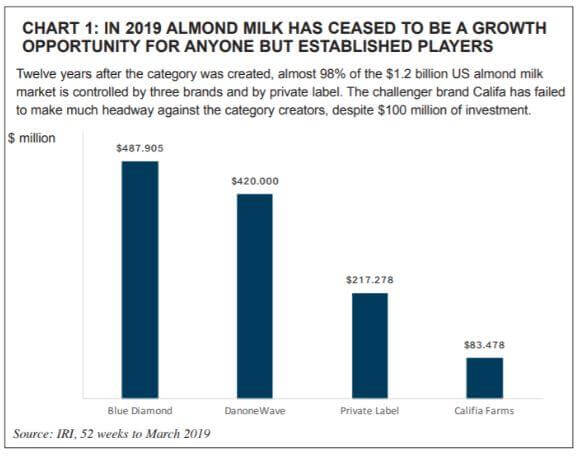
Graph source: [2] NNB
Food and beverage innovation is an area I am hugely passionate about having worked with multinationals and many R&D teams throughout my career. If you want to be more than just a challenger brand and become the go-to brand, you have to invest in R&D and NPD. See here how I can help.
Formulation considerations for plant-based mylks and other hybrid beverages
How can we make an alternative mylk more successful nutritionally and widely accepted by consumers? Consumers are influenced by many elements varying from taste preferences, health goals, ethics, budget, allergies, perceptions and biases about certain foods.
Food and beverage companies need to ensure that their interests are highly consumer-centric if they want their alternative products to be a success. Consumers are impressed by novelty so the alternative needs to make a lasting impression after the novelty has worn off. Dataessential found that 31 per cent of respondents to their survey turned to plant-based products purely as a way to try something new. Think back to the popularity of cauliflower rice and pizza, the hype of which has since cooled off. Making sure a product lasts after the novelty phase is to make it highly nutritional and taste amazing so you can encourage repeat purchases.
Following on from the previous discussion on protein, below is an illustration of the key selection criterion for proteins. A good checklist to keep in mind when comparing a current product or one in the pipeline.
Key Selection Criterion for Proteins

Graph source: [1] Frost & Sullivan
We also need to consider the quality of a protein when comparing dairy milk and plant-based mylks. Consumers will glance at the back of a label and see 5g or 10g of protein from both animal and plant sources and assume they are the same quality. The level of nutritional education is not quite there yet for the average supermarket consumer to understand the quality differences between protein sources.
The FDA has set the daily value for protein intake at 50 grams of high-quality protein per day for the average American consumer. High-quality protein sources are highly digestible and contain all of the essential amino acids our body requires for growth and maintenance. [1]
Below is a graph highlighting some of the more commonly known plant ingredients and comparing their levels of protein and fibre. Seeds, in particular, are high in both areas. Quinoa, although heavily marketed as a protein source, is not the highest in protein on the list. How can we use this knowledge to incorporate more of the high performing ingredients into plant-based mylks and other foods or beverages? Can we process them in different ways to add them into the original product or, in the case of flaxseed and chia seeds, show consumers how to add them as toppings for a fibre and protein boost?
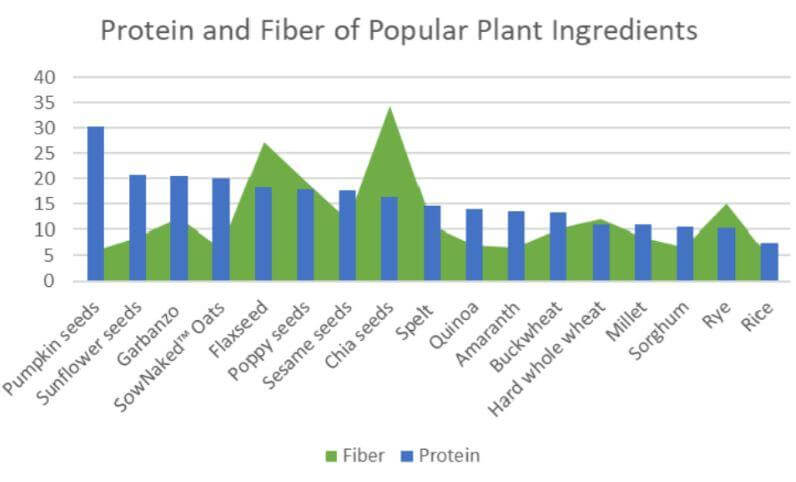
Graph source: [5] IFT
Using a combination of plant proteins is crucial for ensuring that consumers do not become protein-deficient. We need to combine different sources of protein in order to achieve a complete amino acid profile. We also need to increase the quantity of our plant-based protein intake to achieve the same benefits as lower amounts of animal protein sources. Combining different plants together allows for enhanced protein quality and optimal nutrition for the consumer. Variety is best for taste, functionality and nutrition.
The Whey To Go?
We have demonstrated that formulating common plant-based beverages with high-quality proteins can provide a novel approach to enable older adults to meet increasing protein requirements. Whey proteins, in particular, play a key role in supporting healthy ageing through new innovation opportunities as it delivers the health & nutrition benefits consumers are looking for. Formulating with whey proteins combined with other plant-based ingredients can have many benefits in applications such as biscuits and bakery products, ice creams, dietetic food, and infant products. For manufacturers, it opens new positioning and reinforces differentiation or USP’s through the communication of natural ingredients and optimal nutritional profiles with “source of” or “high in” protein and/or fibre claims.
Companies who want to survive in this plant-based food economy will have to step away from an inability to respond to change and traditional strategies. They need to use a combination of marketing creativity and NPD to adjust to the demands of the current consumer.
Flexitarianism is fast becoming a new norm in everyday diets. We need to adjust our product development plans to suit this trend by creating hybrid products which appeal to both plant-based consumers, and those who continue to choose animal-based products.
Through inewtrition, I help food and beverage teams, companies and strategists alike to develop and nourish a culture of Innovation by Design: merging “clean-science” principles, tech and ingenuity to adjust the trajectory of integrative health & wellness through nutrition.
For formulation and renovation projects of V-label or clean-label nutritional and multifunctional foods, please reach out to me for support in developing a culture of excellence around “innovation by design” for current and future launches. Get in touch via email at [email protected] or book a consultation with me directly at a time that suits you.
References:
[1] Frost and Sullivan, file:///C:/Users/bordbia/Downloads/CSIFT%20Plant%20Based%20Proteins_February_2019.pdf
[2] NNB, file:///C:/Users/bordbia/Downloads/NNB__01_2020%20(1)%20(1).pdf
[3] Sethi, S., Tyagi, S.K. and Anurag, R.K. (2016) Plant-based milk alternatives an emerging segment of functional beverages: a review. Journal of Food Science and Technology, 53(9), pp.3408-3423
[4] Vanga, S.K. and Raghavan, V. “How well do plant-based alternatives fare nutritionally compared to cow’s milk?” 2018. Journal of Food Science & Technology 55(1):10–20.
[5] IFT (Institute of Food Technologists), 2019. “Plant-Based Protein from Grains, Seeds and Pulses.”






